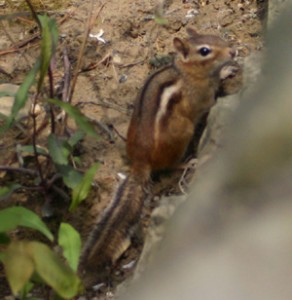General: The eastern chipmunk almost seems obsessed with gathering food. It will spend much of its day gathering and storing food in storage caches that will be used in winter. It borrows into the ground usually no deeper than 3 feet. The tunnel will be roughly 2″ in diameter and can be 10 feet long with chambers for sleeping and food. A chipmunk in the wild has a life span of 1 – 2 years, captive raised chipmunks have lived substantially longer.
They are not true hibernators. They will go into a deep sleep around mid-November through March. They wake every so often to eat and can be seen out on nice winter days(1)
The eastern chipmunk mates in spring. The gestation period is approximately 31 days, The typical litter is born in May of 3 – 5 babies. Young chipmunks begin to emerge from the burrow at 40 days. The female weans and abandons her litter once they come above ground, by either moving them to a nearby burrow, or by leaving her young in the natal burrow while she moves to a new one.(2)
Eastern chipmunks have no value as food or for their fur and as such should be enjoyed as wild animals. Only if they become nuisance animals around the house or farm should there be any attempt to remove or kill them.
Identification: Eastern chipmunks are approximately 8″ – 12″ long (the tail being almost 4″). They have reddish-brown fur on their upper parts. They have a white stripe on each side bordered on both sides by dark stripes. They have one dark stripe running down their back. The stripes stop at the tail. Their belly is white. They have pale facial stripes above and below the eyes.
Habitat: Eastern chipmunks can be found in open deciduous forest, open agricultural areas, mature suburban neighborhoods with appropriate foods. Often times they will be found by stone walls and houses with old foundations.
Territory: The eastern chipmunk can be found in southeastern Canada and most of the northeastern United States from Maine in the North – south to Mississippi and Virginia and west to North Dakota and Oklahoma
Diet: Most of the eastern chipmunk’s diet is made up of nuts, acorns, seeds, mushrooms, fruits, berries and corn. It also eats insects, bird eggs, snails and small mammals like young mice.
(1) National Audubon Society Field Guide to North American Mammals
(2) Adirondack Ecological Center http://www.esf.edu/aec/adks/mammals/chipmunk.htm
